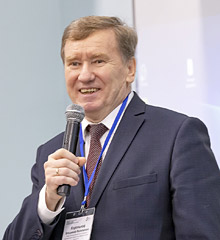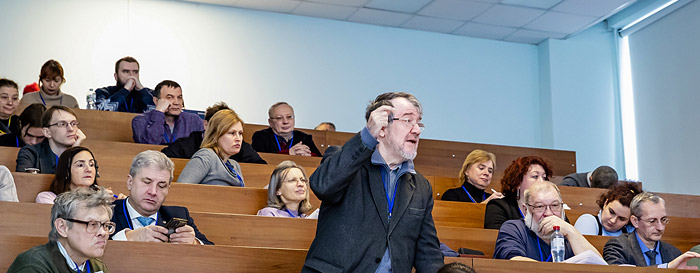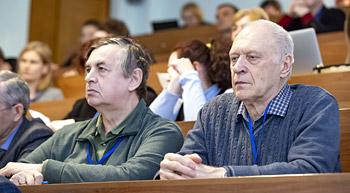
Electronic english version since 2022 |
The newspaper was founded in November 1957
| |
Conferences
MCE-2024 in Dubna: return of traditions
Continuation. Starts at No. 6
Problems of education...
A round table was dedicated to the international aspects of training personnel for major scientific projects at the conference. The further discussion of this issue, as well as the issue of school education, was held in several speeches.
 V.V.Korenkov began his report "Integration of distributed and parallel computing for large scientific projects" by recalling how, at the celebration on the occasion of being awarded the Nobel Prize for the discovery of the Higgs boson, CERN Director Rolf Heuer directly called grid technologies one of the three pillars success, along with the LHC accelerator and physics facilities. CERN's Grid infrastructure has become the benchmark for major scientific projects. Today, not a single large project can be implemented without the use of a distributed infrastructure for data processing. Almost all the data from the CMS experiment are transferred to MLIT for storage, more than 100 centres download this data for processing and analysis from our centre, the speaker noted, we also store the simulation results.
V.V.Korenkov began his report "Integration of distributed and parallel computing for large scientific projects" by recalling how, at the celebration on the occasion of being awarded the Nobel Prize for the discovery of the Higgs boson, CERN Director Rolf Heuer directly called grid technologies one of the three pillars success, along with the LHC accelerator and physics facilities. CERN's Grid infrastructure has become the benchmark for major scientific projects. Today, not a single large project can be implemented without the use of a distributed infrastructure for data processing. Almost all the data from the CMS experiment are transferred to MLIT for storage, more than 100 centres download this data for processing and analysis from our centre, the speaker noted, we also store the simulation results.
"No one will undertake to unite grid clouds, clusters, supercomputers into a single environment, for this is an extremely difficult task, but MLIT knows how to do it," the speaker emphasized. Talking about the infrastructure of the laboratory, V.Korenkov compared the MLIT Multifunctional Information and Computing Centre with a reliable house. It includes a grid infrastructure (Tier1 and Tier2 centres and our Tier1 is significantly superior to European ones in processing experimental data), the Govorun hyperconverged supercomputer and a cloud infrastructure is currently developed, controlled by DIRAC, PanDA and other environments. The tape library together with disk storage is 150 petabytes, the memory system is hierarchical. The main task today is the integration of the MLIT infrastructure into the NICA project.
For all megascience projects in Russia, it is necessary to develop a computer infrastructure similar to the LHC infrastructure, in which good storage, security and data transmission systems should be organized. And everything should be well integrated so that users from different scientific groups can communicate with each other while working on common projects. "We have been trying to develop it for several years. And of course, it requires personnel that are not trained anywhere today," he emphasized.
Cooperation between MLIT and Moscow State University began a long time ago: in the development of software for BESM-6, numerical techniques and computing. Today, it is carried out in the areas of mathematical simulation, grid technologies in Russia, big data analytics, supercomputer technologies and others. The need to train highly qualified personnel in the field of mathematical simulation and data processing for mega-science projects resulted in the idea of developing a training area "Applied Mathematics and Computer Science" at the Moscow State University branch in Dubna.

"Having adopted the Western model of education, we missed the moment when subject knowledge became unimportant," G.V.Novikova (Faculty of Pedagogical Education of Moscow State University) highlighted in the report "Reanimation of teacher education in Russia." The function of education was finally returned to school: it appeared only in the third generation of educational standards. But the concept of functional literacy arose, for the formation of which tasks are built on the principle: solve the problem and then I will tell you the technique. The principle of historicity disappears in the teaching of both history and natural science subjects. Today, there are over 500 techniques of educational technologies and all of them are original, but not tested by the pedagogical community, the speaker noted.
 A classification of schools has appeared and in it - schools with low educational results. Today, there are 250 thousand teacher vacancies in schools and 44% of Russian schoolchildren do not reach the threshold level of education. In the Soviet and Russian schools, conceptual thinking was developed that was identical to scientific thinking. The Soviet school was authoritarian; today, it is considered that forcing a child to teach is inhumane. But in 2020, the Ministry of Education of the Russian Federation approved "Methodological recommendations for the introduction of modern digital technologies into basic general education programmes," and today, among other things, the "gamification" of teaching begins. With bitterness, the author noted that the pedagogical system currently collapses: the ability to learn independently as a learning goal no longer has priority, didactics disappears. And of course, teachers are under pressure from the excessive burden of reporting.
A classification of schools has appeared and in it - schools with low educational results. Today, there are 250 thousand teacher vacancies in schools and 44% of Russian schoolchildren do not reach the threshold level of education. In the Soviet and Russian schools, conceptual thinking was developed that was identical to scientific thinking. The Soviet school was authoritarian; today, it is considered that forcing a child to teach is inhumane. But in 2020, the Ministry of Education of the Russian Federation approved "Methodological recommendations for the introduction of modern digital technologies into basic general education programmes," and today, among other things, the "gamification" of teaching begins. With bitterness, the author noted that the pedagogical system currently collapses: the ability to learn independently as a learning goal no longer has priority, didactics disappears. And of course, teachers are under pressure from the excessive burden of reporting.
In April 2020, Head of Rosobrnadzor Anzor Muzaev stated that "according to the results of all-Russian testing, 35% of Russian schoolchildren do not perform well in one or more subjects of the school curriculum," that is, out of 16.5 million schoolchildren, 5.5 million are poor students. Whereas, in countries that are leaders in education, the underachievers are about 5%. According to the results of PISA-2018 testing in reading literacy, mathematics and natural sciences, our schoolchildren were in the early fourth ten among 79 countries.
D.A.Pichugina (Department of Chemistry, Moscow State University) spoke about "the peculiarities of teaching chemistry to Chinese students at the initial stage of proficiency in the Russian language." The attractiveness of Russian education increases: if in 2000, there were 50 thousand foreigners studying, then in 2023, there will be over 350 thousand (data from the Ministry of Education and Science). They enter MSU, HSE, RUDN, St. Petersburg Polytechnic, Kazan Federal and Ural Federal Universities. From the report we learned the history of the issue. Back in the 16th century, Russian language and literacy were taught in Rus' to foreigners: translators, diplomats and merchants. Since 1865, students from the Balkan countries (Bulgaria and Serbia) have studied free of charge at St. Petersburg, Moscow and Novorossiysk universities. Since 1946, communist youth from Poland, Bulgaria and Hungary have gained access to education in the USSR. At Moscow State University, Russian language courses for foreigners were developed in 1954 and the first students were students from Vietnam. Today, these courses have grown into the Institute of Russian Language and Culture of Moscow State University and over the entire time, over five thousand people have passed through them.
Speaking online from China, Sh.Yu.Khapchaev (Shenzhen, joint Russian-Chinese university MSU - Beijing Polytechnic Institute in Shenzhen) spoke about the experience of creating a special textbook for Chinese biology students.
...And the economy
The traditional section of the conference is "Social and economic research. Analysis and simulation of social and economic processes." A.E.Varshavsky (Central Economics and Mathematics Institute) in his report "On the need for a transition to a harmonious distribution of income" asked the question: what level of income distribution should we strive for? For the United States, a proposal was made by Nobel winner D.Stiglitz: by 2030, the Palma index should be equal to one (when the income of the richest 10% is equal to the income of the poorest 40%). In 2017, this index in the United States was 1.76. According to experts, the Gini index (a macroeconomic indicator characterizing the degree of stratification of society) in Russia is no lower than 44 and even 47 and according to underestimated Rosstat data - 42 (2014), 39.5 (2022), for Moscow - 42.1 (2016). For comparison: in the USSR (when today's stratification of society did not exist) in 1989, it was 23.8, in 1991 - 26. Unlike the USA and Europe, in Russia the Gini ratio does not change after paying personal income tax, that is, inequality does not decrease. The author cites the distribution of the population of Russia by class status (Complete Works of V.I.Lenin, vol.3, p.505). Of the 125.600 thousand, only 3 million (2.4%) were the big bourgeoisie, landowners and high ranks; wealthy small owners - 23.1 million (18.4%); the poorest smallholders - 35.8 million (28.5%); proletarians and semi-proletarians - 63.7 million (50.7%). In the first half of 2015, according to Rosstat, 21.7 million people (15.1% of the total population) found themselves with incomes below the subsistence level in Russia; in 2021 - 16 million (11%). If we adhere to foreign standards, then according to the author's estimates, the poor in our country are from 25 to 30% of the population or 36-43 million people.
In addition to economic inequality, spatial inequality also persists. The very large gap in income levels between Moscow and most other regions has resulted in a centripetal movement of the Russian population towards the Moscow metropolis. As a result of the ultra-high focus of the population in Moscow and the region, the most serious issues are the increasing threat to economic, scientific, technological and national security, ensuring the territorial integrity of the country in the context of increasing global instability. The result is regional differentiation of income: if Moscow's income is taken as 1, then the income of the Moscow region is 0.65, Novosibirsk - 0.35, Rostov - 0.3, Orlov - 0.25. Increasing the rate for the richest 20% from 13% to 26% would result in an increase in income from personal income tax in Moscow by about 565 billion rubles. Last year, the budget received only 300 billion rubles in additional fees from large companies. It is important for us to become a socially oriented economy, the speaker noted that is characterized by a harmonious (close to the golden ratio) distribution of income between different groups of the population and explained what it is.
Among the harmonic proportions, the most famous is the golden ratio. It was proposed by Leonardo da Vinci's friend Luca Pacioli, a mathematician that laid the foundations of accounting. Other proportions are less commonly used - the silver section and the plastic section. With the golden ratio, the author noted, Stieglitz's dream comes true. A.E.Varshavsky developed a model and having compared its results with real data for countries with socially oriented economies, found out that they are characterized by a harmonious distribution of income between equal groups of the population that is close to the golden ratio. At the same time, the author concludes, personal income tax should be made federal (in 2023, Moscow's share in personal income tax was over 23% and the share of personal income tax in Moscow budget revenues was 45%). It should be taken into account that there is no single scientific truth regarding the ideal level of inequality and it is likely that the size of the territory and population of each country should be taken into account. State policy should promote the redistribution of income by introducing a progressive personal income tax scale.
To be continued
Olga TARANTINA,
photo by Elena PUZYNINA